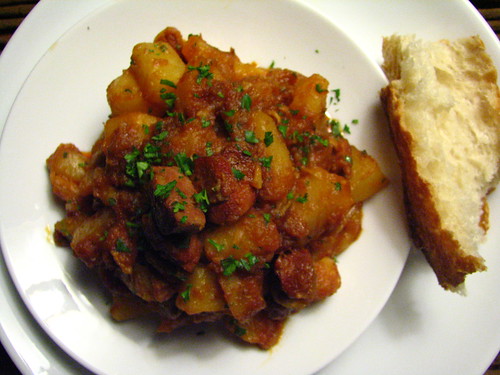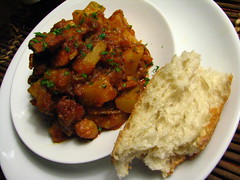It’s widely known that humble ingredients prepared with simple techniques often produce the best dishes, and it’s becoming more widely known that this philosophy lies at the very heart of Spanish cooking – a cuisine that has, in the last five or so years, become one of the most celebrated “new finds” of foodies everywhere. As a result of this, there has been a great deal of interest in tapas and the cuisine and culture surrounding these small plates/finger foods. All of which, in my view, can only be a good thing, even if many of these new “tapas restaurants” (itself, again in my view, an oxymoron) serve few, if any, authentic Spanish dishes.
Indeed, and here lies the rub, in their rush to capitalize on the latest food trend, it seems everyone is trying to outdo everyone else on the cleverness factor. Expanding their menus to include all sorts of dishes resembling “tapas” only in the fact that they are served in small quantities. It’s almost as if the tasting menus of high-falutin’ restaurants have become conflated with “tapas” so that you get tiny dishes and are charged through the nose for them.
Now, we here at WeAreNeverFull.com, perhaps contrary to popular opinion, are not against experimentation or new dishes in the slightest. Quite the contrary, in fact, we are always ready to try new things. However, and again, this may just be our view, so feel free to comment disagreeing, we feel that developing all these new and complicated dishes and calling them tapas is fundamentally against the spirit of tapas as a style of eating, outlined above.
 |
The term tapas, as I’m sure many of you know, is derived from the Spanish word tapa, meaning a lid, and originally connoted a slice of bread or cheese that certain tavern owners used to serve across the top of the drinking vessel, perhaps as a way of keeping out unwanted bugs. Over the centuries this has developed into a wondrous variety of small dishes, now commonly on plates and cocktail sticks, as well as on rounds of bread, that are served to accompany su caña – whatever you are drinking at the bar. Indeed, it has become so refined a practice that many bars, while they might serve a lot of different tapas, are famous for one in particular, a signature tapa, that those in the know only eat at that one bar. So, as you can see, tapas has come a long way from its beginnings as a humble drink lid. That said, the original ethos of simple but tasty accompaniments remains.
 |
We’ve traveled extensively in Spain and eaten, it must be said, an obscene amount of tapas over the past several years, and the consistent theme has been that the ingredients and the simple, time-honored preparations and take center stage, not the ego of the preparer. And this has never been more true than in the case of patatas a la Riojana. So, so simple, unbelieveably good. Really. Potatoes, chorizo, onions, garlic, sweet paprika and water, combine to create a dish that is without a doubt my favorite tapa. And, if I may name-drop shamelessly, I am not in bad company when I say that. Legendary chef and father of nouvelle cuisine Paul Bocuse, no less, while at a culinary convention in Spain in the late 1970s, described patatas a la Riojana as among the “greatest dishes created by man.”
And here is the interesting thing. If Bocuse, a man whose entire reputation was built on small, artfully-plated dishes, found this humble and rustic dish such a revelation, why is it that so many lesser chefs of today are trying so hard, and in many cases failing, to improve upon these time-honored preparations?
 |
Nearly everyone knows that La Rioja is Spain’s most famous wine appellation, but it is also known, mostly inside Spain, as being the origin of many good things to eat. Piquillo peppers are the regions’ second best known export, and together with wild mushrooms, chorizo, river crabs, bream and trout they combine to make many dishes synonymous in the Spanish stomach with La Rioja. In fact, it is the inclusion of a typical Riojan dry chorizo that makes this preparation “a la Riojana” or Rioja-style.
Personally, I would eat this dish three times a week, but if my recommendation that you try making it isn’t good enough for you, then I’m sure you’ll pay attention to the wise words of Monsieur Bocuse.
Ingredients: (serves 4)
- 3 tbsp extra virgin olive oil
- 2 cloves garlic, chopped roughly
- 1 small onion (or half a large one) finely sliced
- 7 ounces (or 2-3 links) chorizo, sliced into rounds
- 1/2 pound floury potatoes (idaho or similar), peeled and cubed
- 1 tsp pimenton dulce (sweet paprika)
- 1 tsp kosher salt, or more, to taste
- 1/2 – 1pint (1/2 liter) cold tap water
 |
Recipe: (adapted slightly from Jose Andres’ Tapas: A Taste of Spain in America
- Warm olive oil over medium heat and add garlic.
- Cook for about a minute until golden before adding onions, and sauteing them gently for 20 minutes or so, until light brown.
- Add chorizo and cook until this also is browned, about 2 minutes.
- Place the potatoes in the pan and stir to coat with oil. Cook for 10 minutes.
- Now sprinkle over the pimenton and pour in enough water to almost cover potatoes and chorizo. Put lid on pan and bring to a boil, then lower heat and simmer for about 20 minutes or until liquid is reduced by half.
- Serve immediately with lots of crusty bread and a hearty red Rioja. Unbelieveably delicious. Trust me.
- Unsurprisingly, this is quite a filling dish, but fear not, as left-overs, eaten either cold or reheated the next day are even better as the flavors continue to meld together.
